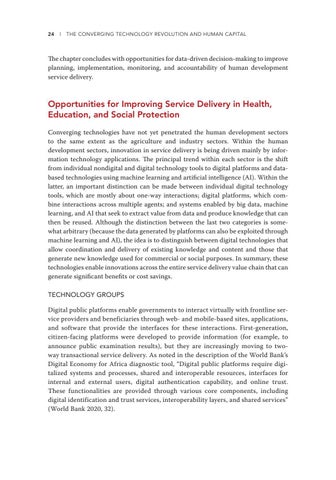24 l THE CONVERGING TECHNOLOGY REVOLUTION AND HUMAN CAPITAL
The chapter c oncludes with opportunities for data-driven decision-making to improve planning, implementation, monitoring, and accountability of human development service delivery.
Opportunities for Improving Service Delivery in Health, Education, and Social Protection Converging technologies have not yet penetrated the human development sectors to the same extent as the agriculture and industry sectors. Within the human development sectors, innovation in service delivery is being driven mainly by information technology applications. The principal trend within each sector is the shift from individual nondigital and digital technology tools to digital platforms and databased technologies using machine learning and artificial intelligence (AI). Within the latter, an important distinction can be made between individual digital technology tools, which are mostly about one-way interactions; digital platforms, which combine interactions across multiple agents; and systems enabled by big data, machine learning, and AI that seek to extract value from data and produce knowledge that can then be reused. Although the distinction between the last two categories is somewhat arbitrary (because the data generated by platforms can also be exploited through machine learning and AI), the idea is to distinguish between digital technologies that allow coordination and delivery of existing knowledge and content and those that generate new knowledge used for commercial or social purposes. In summary, these technologies enable innovations across the entire service delivery value chain that can generate significant benefits or cost savings. TECHNOLOGY GROUPS Digital public platforms enable governments to interact virtually with frontline service providers and beneficiaries through web- and mobile-based sites, applications, and software that provide the interfaces for these interactions. First-generation, citizen-facing platforms were developed to provide information (for example, to announce public examination results), but they are increasingly moving to twoway transactional service delivery. As noted in the description of the World Bank’s Digital Economy for Africa diagnostic tool, “Digital public platforms require digitalized systems and processes, shared and interoperable resources, interfaces for internal and external users, digital authentication capability, and online trust. These functionalities are provided through various core components, including digital identification and trust services, interoperability layers, and shared services” (World Bank 2020, 32).

